Figure 3.
Hazard ratio, risk of death. Six different statistical models were fitted to compare estimated Cox proportional hazard ratios for death at any time during the study period (A) or death within 30 days (B) for men and women after acute myocardial infarction. We also performed subgroup analyses by Cox proportional hazards regression models for death at any time during the study period (C) or death within 30 days (D). Subgroup analyses were performed using models adjusted for risk factors and including interaction terms. P values refer to the interaction term between categories and gender. #Primary model. *Adjusted for age, smoking habits, hypertension, diabetes, hyperlipidemia, previous myocardial infarction, previous cardiac surgery, previous PCI, STEMI, and calendar year. #Variables included in propensity scores: age; smoking habits; hypertension; diabetes; hyperlipidemia; previous myocardial infarction; previous cardiac surgery; previous PCI; STEMI and calendar-year BMI; prehospital cardiac arrest; cardiogenic shock; in-hospital heart failure; whether the patient received revascularization treatment; and whether the patient was discharged with β-blocker, aspirin, ACEI/ARB, antiplatelet therapy, oral anticoagulant, and/or statin. ACEI indicates angiotensin-converting enzyme inhibitor; ARB, angiotensin receptor blocker; BMI, body mass index; HR, hazard ratio; NSTEMI, non–ST-segment elevation myocardial infarction; PCI, percutaneous coronary intervention; STEMI, ST-segment elevation myocardial infarction.

